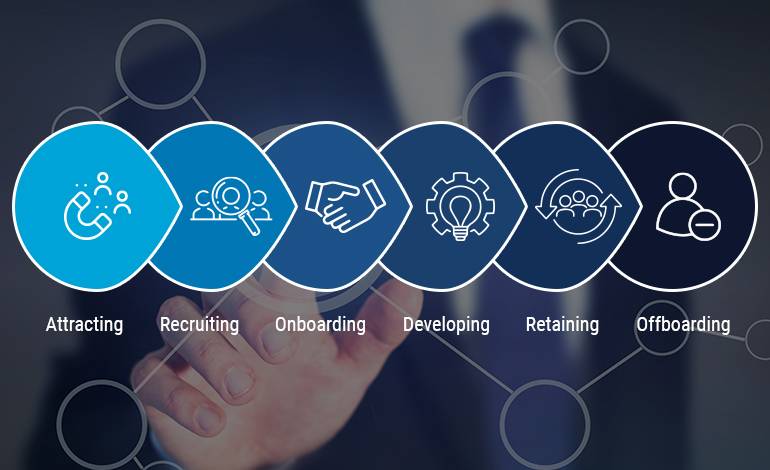Your employees are the lifeblood of your business, and your operation would grind to a financially devastating halt without them. To keep your firm stocked with top talent, treat your workforce as your most important asset – because it is. But the royal treatment needs to happen more than once; it’s ongoing throughout the entire employment relationship. We refer to this as the Employee Lifecycle and we’ve got tips for you to optimize each phase.
What is the Employee Lifecycle?
Before we get into employee lifecycle optimization strategies, let’s get clear on what the term means. The employee lifecycle is the journey your team member takes while they’re connected to your organization. It’s comprised of six distinct phases:
- Attracting
- Recruiting
- Onboarding
- Developing
- Retaining
- Offboarding
Let’s briefly discuss each phase.
Attracting
The attracting phase is all about enticing professionals to work for your company. Brand perception is key, and prospective talent will look at your mission, vision, values, culture, and reputation to determine if they can see themselves working for your organization. If they feel aligned with your firm’s beliefs and actions, they’ll be much more likely to participate in the next phase, recruiting.
Recruiting
The recruiting phase involves posting job advertisements, screening and interviewing applicants, and making job offers. Candidates will pay close attention to every aspect of the recruitment experience and take note of how they feel. If they come away with positive emotions, they’ll be more inclined to accept an employment offer and move into the onboarding phase.
Onboarding
The onboarding phase is when a candidate officially becomes an employee. It involves completing paperwork, going through a new hire orientation, meeting other key team members, and getting acquainted with the environment and position. If it’s done well, the recent addition will settle in and start building their career at the company.
Developing
The developing phase is when an employee continues to learn and grow as a professional. It could include pursuing or finishing degrees, earning industry certifications, participating in training opportunities, being mentored, taking on new responsibilities, and more. This indefinite stage should demonstrate that a long-term, progressive career is possible at your company.
Retaining
The retaining phase is an ongoing effort to keep your best talent within the organization and performing at their peak. It involves giving regular raises, offering a competitive benefits package, providing opportunities for advancement, making each employee feel appreciated, welcome, and heard, and more. If the company excels at this stage, an all-star team member will be less likely to leave. When the team member is thriving in this phase, they’re likely to recommend and refer potential employees to join the team.
Offboarding
The offboarding phase, also known as the separation phase, occurs when an employee leaves the firm for several reasons such as pursuing another career opportunity, being let go, or retiring. It involves activities like filling out termination paperwork, conducting an exit interview, collecting company property, etc. A well-executed offboarding phase results in employee referrals from the departing worker or a rehire situation in the future.
Why it’s Critical to Optimize Your Company’s Employee Lifecycle
Each phase of the cycle is an opportunity for your company to attract and retain the human capital it needs – or repel it. That means your organization should get every step as close to perfect as possible. As a leader, you don’t want to struggle to recruit the employees required to run the company effectively. You also don’t want to see essential expertise walk out the door because your competitor offers more money, benefits, opportunity, recognition, or appreciation.
Employee Lifecycle Optimization Tips
To avoid the stress and financial impact of missing out on or losing vital talent, consider following the best practices listed below.
For Attraction
To become well-known as an employer of choice, your company should:
- Appear in the media regularly.
- Publish thought leadership.
- Get active on social media.
- Encourage your employees to be vocal about their experience with the company
For Recruitment
To recruit ideal candidates, you should:
- Be clear on what education, skills, personality traits and qualifications are required – and be flexible on the nice-to-haves.
- Make the recruiting process as straightforward as possible, so candidates don’t have to jump through hoops.
- Use multiple sourcing methods, such as internal job postings, employee referrals, job fairs, social media advertisements, various job boards, etc.
- Offer a competitive salary, comprehensive benefits, and an accepting, engaging employee culture.
For Onboarding
To integrate new employees effectively, leadership should:
- Provide the tools employees need to start working – make sure they have the equipment and passwords, and access to all resources prior to their first day to make for a seamless start.
- Make them feel welcome instantly – send a welcome package, arrange for an in-person meet and greet where possible, and make sure everyone on the team is appropriately introduced.
- Conduct orientation to acquaint them with policies, procedures, and the employee benefits package.
- Be available to answer questions and give extra support.
For Development
To ensure every employee has ample opportunities for professional development, your firm should:
- Meet with each member of the workforce to discuss their career goals and identify gaps in their skillset on a regular cadence.
- Encourage workers to take on new responsibilities and special projects.
- Offer training sessions – both in-house and from external vendors.
- Consider starting a mentorship program.
- Try to offer education-related benefits, like a training stipend or tuition reimbursement.
For Retention
To keep high performers within the organization for the long haul, your company should:
- Treat each employee as a person by taking an interest in their life and showing empathy when needed.
- Survey the workforce annually to get feedback and gauge satisfaction and engagement.
- Involve team members in the decision-making and goal-setting processes whenever possible.
- Update the compensation and benefits package regularly to ensure it remains competitive.
- Have a succession plan for critical roles and show high-achievement employees what they can do to reach the next level with the firm.
For Offboarding
To offboard departing team members successfully, your organization should:
- Ask the employee why they’re leaving (if they quit) to see if any trends emerge.
- Request feedback on what the firm does well and where it could improve.
- Celebrate the team member’s career highlights. If they’re retiring and people can come together, a celebration is definitely called for. For those leaving by your choice or theirs, be transparent with the team and send the person off with a kind farewell that celebrates their impact.
- Cut the worker’s final check promptly and make sure they understand what will happen to their benefits.
- Keep team morale high by remaining positive – no matter how tough the loss is.
If you implement these tips, your company’s employee lifecycle should be much stronger.
How Omnia Can Help
The key to hiring the right talent and getting the most out of your workforce is to truly understand them. It can take years to learn what makes someone truly tick, and you don’t have that kind of time. It’s critical to understand a job candidate’s strengths, weaknesses, and preferences immediately. You’ll take it to another level by being familiar with a new hire’s communication style, work habits, and motivations as soon as possible.
That’s where an Omnia behavioral assessment can help. Our assessment is easy to administer, and you’ll get detailed, insightful results right away. Once your candidate takes the assessment, you’ll know how well they’ll fit into the organization and position. When a current employee takes it, you’ll learn how to best utilize their talent, communicate with them, motivate them, and easily spot ways to develop and expand their impact as they grow in their career through new opportunities within your firm.
Final Thoughts
To keep your candidate pool and employee base engaged, it’s imperative to take good care of people throughout their entire journey with your company. I recommend following these tips to optimize the employee lifecycle from hiring through retirement. If you’d like more guidance, we’re here for you. Contact Omnia today!
Speak to the Author!
Have an article-specific question or want to continue the conversation? Now you can! Contact the author directly through the short form below and Keather Snyder will respond to your query. If you have a more general question please use our chat function, call 800.525.7117, or visit our contact us page and we’ll have a subject matter expert answer your questions.























